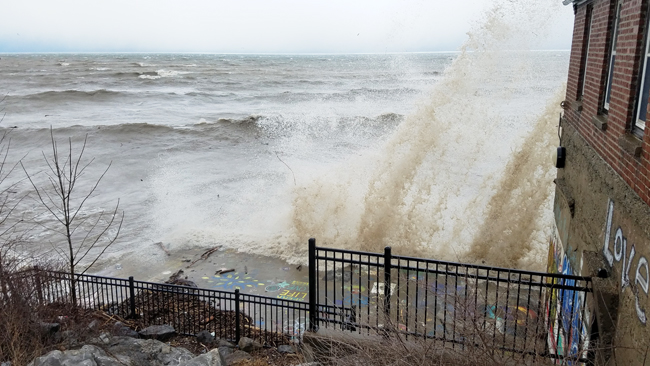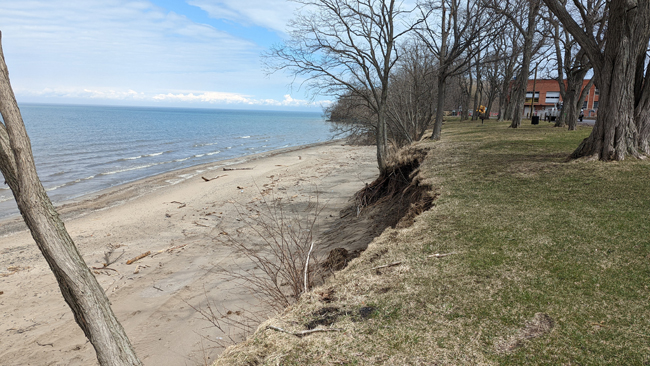
A seiche strikes a building at Buffalo, New York. Credit: NYSDEC
Contacts:
Roy Widrig, NYSG Great Lakes Coastal Processes and Hazards Specialist, E: rlw294@cornell.edu, P: (315) 234-1916
Kara Lynn Dunn, NYSG's Freelance Great Lakes Publicist, E: karalynn@gisco.net, P: (315) 465-7578
Irving, NY, May 8, 2025 - New York Sea Grant, the Sunset Bay Association, and the New York State Department of Environmental Conservation (DEC) will hold a workshop on Friday, June 13, 2025 to help waterfront property owners, municipal leaders, and natural resource managers better understand the climate and weather patterns that influence seiche events, erosion, and flooding along New York’s Lake Erie shoreline.
The workshop will be held from 1:00 to 4:00 p.m. at the Sunset Bay Volunteer Fire Station 1 at 12798 Allegany Road in Irving, New York. Registration is encouraged for this free workshop. To register, visit www.nyseagrant.org/glcoastal. For more information, call New York Sea Grant at (315) 312-3042.
The workshop will include informational presentations by retired National Weather Service personnel on weather patterns that cause seiches, New York Sea Grant (NYSG) coastal processes staff on the management of sandy shoreline, and DEC staff on Coastal Erosion Hazard Areas in New York and DEC permitting requirements. Copies of a “Seiche Events on Lake Erie” fact sheet authored by NYSG Coastal Processes and Hazards Specialist Roy Widrig will be available to workshop attendees.
Seiche (pronounced ‘saysh’) events can drive prolonged standing waves of 8 feet or more against the eastern Lake Erie shoreline. Five of the top 10 recorded Lake Erie seiches near Buffalo have occurred since 2019, according to the National Oceanic and Atmospheric Administration. Widrig notes, “Recent intensified seiche events along Lake Erie have caused more shoreline erosion in low-lying coastal areas, flooding, and dangerous rip currents. ”
Climate patterns suggest that the risk of seiche impact along Lake Erie may intensify, particularly in years when the lake does not ice over.
Funding for this program is provided by the New York State Environmental Protection Fund, under the authority of the New York Ocean and Great Lakes Ecosystem Conservation Act, in cooperation with NYSDEC’s Great Lakes Program.

Erosion along the Lake Erie shoreline has exposed tree roots and damaged the bluff. Credit: Roy Widrig/NYSG
More Info: New York Sea Grant
Established in 1966, the National Oceanic and Atmospheric Administration (NOAA)’s National Sea Grant College Program promotes the informed stewardship of coastal resources in 34 joint federal/state university-based programs in every U.S. coastal state (marine and Great Lakes) and Puerto Rico. The Sea Grant model has also inspired similar projects in the Pacific region, Korea and Indonesia.
Since 1971, New York Sea Grant (NYSG) has represented a statewide network of integrated research, education and extension services promoting coastal community economic vitality, environmental sustainability and citizen awareness and understanding about the State’s marine and Great Lakes resources.
NYSG historically leverages on average a 3 to 6-fold return on each invested federal dollar, annually. We benefit from this, as these resources are invested in Sea Grant staff and their work in communities right here in New York.
Through NYSG’s efforts, the combined talents of university scientists and extension specialists help develop and transfer science-based information to many coastal user groups—businesses and industries, federal, state and local government decision-makers and agency managers, educators, the media and the interested public.
New York Sea Grant, one of the largest of the state Sea Grant programs, is a cooperative program of the State University of New York (SUNY) and Cornell University. The program maintains Great Lakes offices at Cornell University, SUNY Buffalo, Rochester Institute of Technology, SUNY Oswego, the Wayne County Cooperative Extension office in Newark, and in Watertown. In the State's marine waters, NYSG has offices at Stony Brook University and with Cornell Cooperative Extension of Nassau County on Long Island, in Queens, at Brooklyn College, with Cornell Cooperative Extension in NYC, in Bronx, with Cornell Cooperative Extension of Ulster County in Kingston, and with Cornell Cooperative Extension of Westchester County in Elmsford.
For updates on Sea Grant activities: www.nyseagrant.org, follow us on social media (Facebook, Twitter/X, Instagram, Bluesky, LinkedIn, and YouTube). NYSG offers a free e-list sign up via www.nyseagrant.org/nycoastlines for its flagship publication, NY Coastlines/Currents, which it publishes 2-3 times a year.